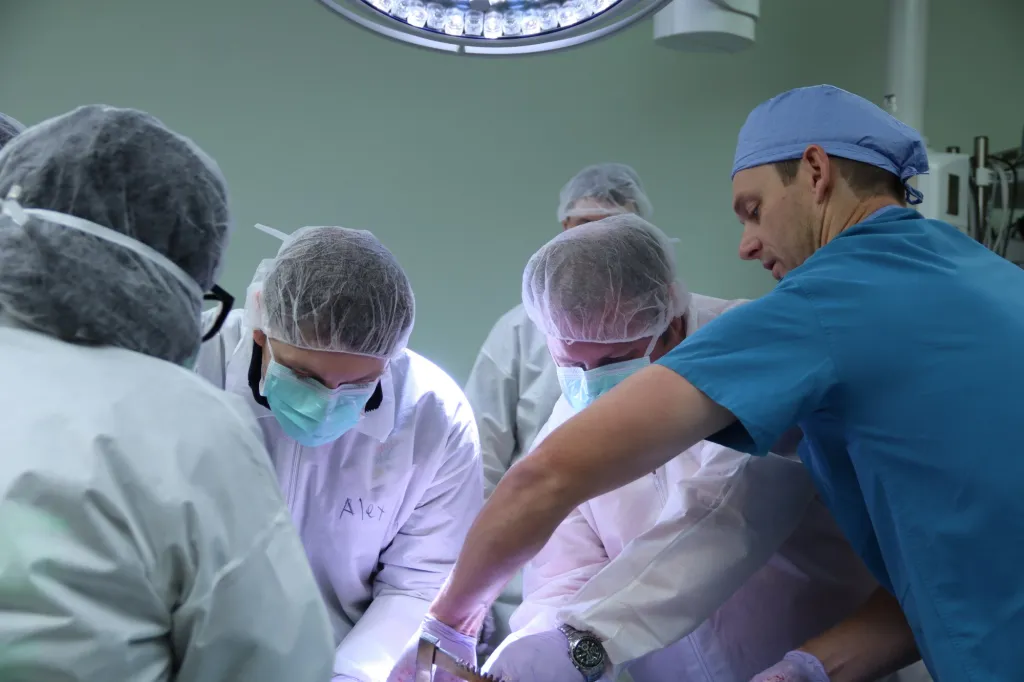Copyright Norfolk Virginian-Pilot

On Friday morning, 21 EMS providers from across the Peninsula donned “bunny suits” at Sentara Williamsburg Regional Medical Center. They weren’t getting dressed for trick-or-treating, though — they were getting ready for a cadaver lab class. Sentara Williamsburg held six two-hour classes Thursday and Friday, with a total of 107 participants, including current Sentara employees, emergency medical technicians and a pre-med student from William & Mary. Emergency services providers from across the Peninsula attended, including from Chesapeake, Hampton, York County and New Kent County. Sentara Williamsburg is the only hospital in the area that offers cadaver labs to local EMS; Virginia Commonwealth University and Eastern Virginia Medical School both have cadaver labs, but their respective residency programs make it difficult for local EMS to get in. Last week was the third time Sentara has offered the class, according to Lauren Faunce, trauma program manager. This year, in addition to filling the need for hands-on trauma practice, the class was part of the hospital’s efforts to strengthen community relations with local EMS providers as the hospital builds its trauma program and works toward its Level III trauma center designation. Virginia has five recognized trauma designations, from Level I for the most severely injured patients to Level III. As a Level III center, Sentara Williamsburg would focus on emergency care and stabilization, as well as coordinating transfers to higher-level facilities for more complex injuries. According to Faunce, the hospital submitted its application in August. It’s now awaiting a date for a site review and verification, which is expected to happen next summer. Dr. Taylor Walsh, a general surgeon and trauma medical director, said the cadaver lab was two-fold. “We obviously want to put a spotlight on what services we can provide as we’re going through our trauma application, and then also … help provide high-quality education and live reps for EMS crews that may not do it a ton,” he said. Each class consisted of three 30-minute stations that allowed participants to practice various procedures on cadavers. One involved creating airways using bag valve masks and laryngoscopes for inserting tubes while another focused on inserting a specialized needle into a leg and an arm. The third station was a chest simulation led by Walsh. It involved needle decompression and a thoracostomy, where a hole is cut into the side of the chest to insert a tube. It’s commonly used when a patient has a collapsed lung or fluid buildup. In the last 20 minutes of the class, Walsh walked participants through what would happen in an emergent situation where a thoracotomy — when a surgeon opens the thoracic cavity to see or treat the organs — has to be performed on a trauma patient who could lose their life within 20 minutes or less. While EMS providers may not need to regularly perform these procedures, the hospital wants them to have the knowledge and opportunity to practice on actual bodies rather than mannequins. Many of the EMS providers who attended echoed those sentiments. “These (classes) are really important and super helpful,” said Joshua Fulton, a paramedic with the James City County Fire Department. Fulton and two other James City County paramedics with him, Jake Laflam and Jake Gassner, had taken the class before, but chose to do it again this year because of the limited opportunities they get to practice these trauma treatment skills. “Being able to actually feel what entering through the skin is like is really helpful,” Fulton said. “Even if people are squeamish, they still make an effort to come out here.” The classes make a “huge difference” in the paramedics’ abilities to provide quality patient care, Laflam added. Hampton resident JR Giles, who is training to be an advanced EMT, attended one of the Thursday classes. While he agreed with Walsh that some of the skills were outside the scope of what local EMTs would typically deal with, he still felt they were important to know. “It’s always good to keep practicing these skills and become more comfortable with these procedures,” Giles said. “They did a really good job.” Walsh said it’s important to the hospital that EMS providers not only get a chance to practice skills, but also get to know they can come to Sentara Williamsburg if they have a trauma patient — even though Sentara isn’t a designated trauma center yet. Elizabeth Marquardt, the hospital’s trauma educator and a registered nurse, said the hospital pulls from a wide range of localities, including as far north as King and Queen County, so making the EMS community aware that Sentara Williamsburg is an option is crucial. Williamsburg is in a “unique area” in terms of hospital care, Walsh said. There are 20 designated trauma centers in Virginia, including three in the Hampton Roads area: Sentara Norfolk General Hospital, Riverside Regional Medical Center and Sentara Virginia Beach General Hospital. While there is one of each level on the Peninsula — Norfolk General is a Level I, Riverside Regional is a Level II and Virginia Beach General is a Level III — the distance can be a problem. “It’s 35 to 45 minutes to the next closest trauma center (from Sentara Williamsburg),” Walsh said. “If you have trauma patients, it takes an ambulance out of commission for that. If New Kent County needs to drive to Riverside, they have to drive all the way across James City and York, and now they don’t have an ambulance in session.” Feedback from local EMS providers has largely been that they’re happy to not have ambulances out of commission for hours at a time, especially in an instance where a patient has minor trauma, Walsh said. “Keeping people in their communities, that’s our main goal,” he said. Haidyn Brockelman, haidyn.brockelman@gmail.com



